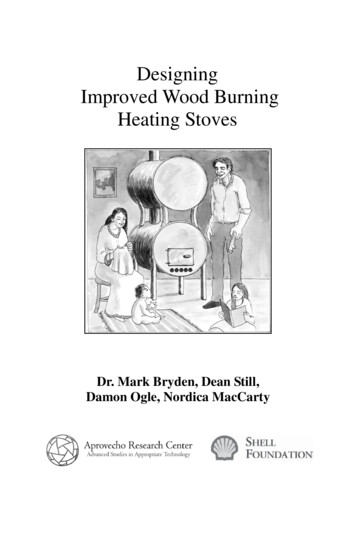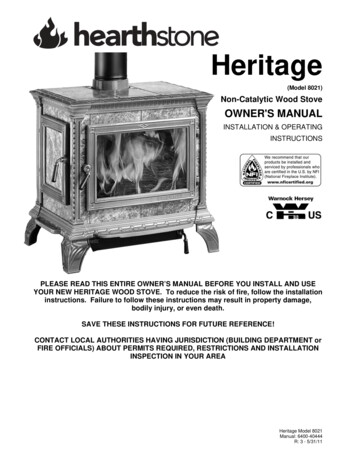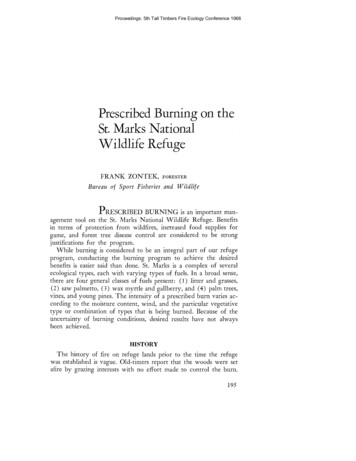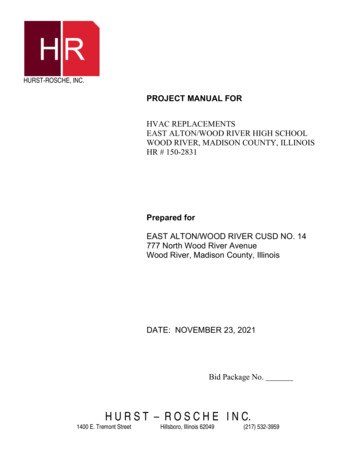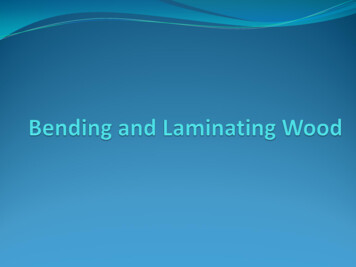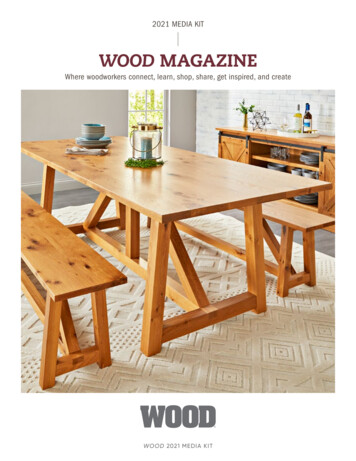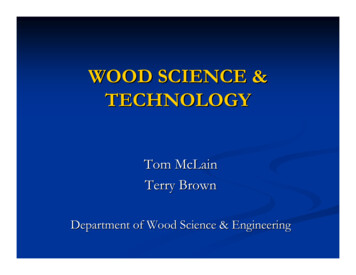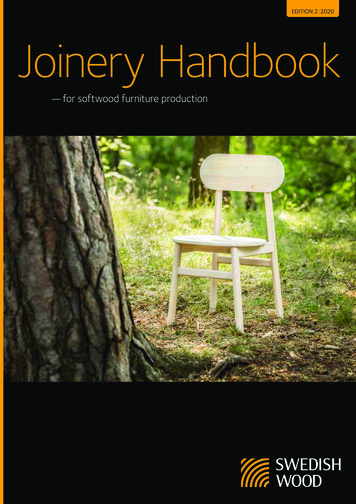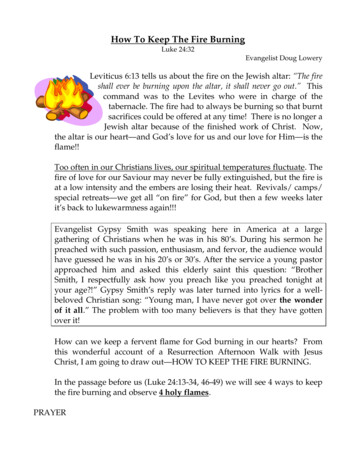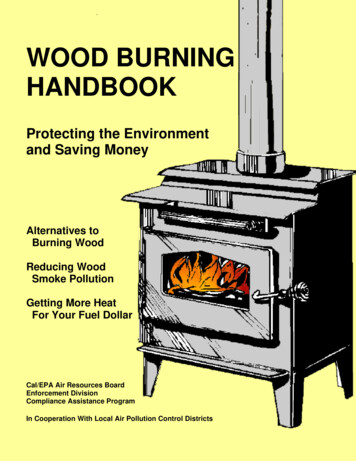
Transcription
WOOD BURNINGHANDBOOKProtecting the Environmentand Saving MoneyAlternatives toBurning WoodReducing WoodSmoke PollutionGetting More HeatFor Your Fuel DollarCal/EPA Air Resources BoardEnforcement DivisionCompliance Assistance ProgramIn Cooperation With Local Air Pollution Control Districts
Burning Wood Produces Wood Smoke and Air Pollution!The California Environmental Protection Agency and your local air district are asking you to help clearthe air of wood smoke. In this handbook you will find information about the air pollutants in woodsmoke, health effects of smoke, how wood burns, why it smokes and how you can reduce woodsmoke pollution.Smoke from neighborhood stoves and fireplaces, a common source of both odor and reducedvisibility, greatly contributes to the air pollution problems people complain about most. When youinclude the health-related problems caused by inhaling smoke pollutants, health costs for individualsand the community can be significant. To be a good neighbor, eliminate wood burning. If you do burn,learn to limit the amount of wood smoke produced.Sources of Wood Burning and Air Pollution Air pollution affects millions of Californians every day.It damages our health, our crops, our property and ourenvironment. In neighborhoods everywhere acrossCalifornia, residential wood burning is a growingsource of air pollution. Most wood heaters, such aswoodstoves and fireplaces, release far more airpollution, indoors and out, than heaters using otherfuels. In winter, when we heat our homes the most,cold nights with little wind cause smoke and airpollutants to remain stagnate at ground level for longperiods.Burning Wood Causes Indoor AirPollutionHigh levels of smoke pollutants leaking from stoves andfireplaces have been measured in some wood burninghomes. If you or family members suffer from chronic orrepeated respiratory problems like asthma oremphysema, or have heart disease, you should not burnwood at all. If you must burn wood, make sure your stoveor fireplace doesn't leak and that you operate it correctly.Remember - If you can smell smoke, you are breathing smoke!1
What Happens when Wood Burns?Complete combustion gives off light, heat, and the gases carbon dioxide and water vapor. Becausewhen wood burns complete combustion does not occur, it also produces wood smoke, which containsthe following major air pollutions, regulated by State and federal rules because of their known healtheffects:Carbon Monoxide (CO) – An odorless, colorless gas, produced inlarge amounts by burning wood with insufficient air. CO reduces theblood’s ability to supply oxygen to body tissues, and can causestress on your heart and reduce your ability to exercise. Exposure toCO can cause long-term health problems, dizziness, confusion,severe headache, unconsciousness and even death. Those most atrisk from CO poisoning are the unborn child, and people with anemia,heart, circulatory or lung disease.Oxides of Nitrogen (NOx) – NOx impairs the respiratory system andits ability to fight infection. NOx also combines with VOCs to makeozone and with water vapor to form acid rain or acid fog.Volatile Organic Compounds (VOCs) – Evaporated carboncompounds which react with NOx in sunlight to form ozone(photochemical smog). Ozone injures the lungs and makes breathingdifficult, especially in children and exercising adults. NOx and VOCsalso form particulate matter through reactions in the atmosphere.Toxic Pollutants - Wood smoke also contains VOCs which include toxicand/or cancer-causing substances, such as benzene, formaldehyde andbenzo-a-pyrene, a polycyclic aromatic hydrocarbon (PAH). Manufacturedfireplace logs, for instance, are not recommended for burning becausethey produce toxic fumes, including PCBs (polychlorinated biphenyls).Researchers are now studying these and other smoke products to learnmore about their effects on human health.Particulate Matter less than 10 microns indiameter (PM10) are very small droplets ofcondensed organic vapors of wood tar and gases.These particles are a result of unburned fuel andhave a diameter of 10 microns or smaller (thediameter of a human hair is about 50 to 100microns), which allows them to be inhaled into thelungs. Exposure to PM10 aggravates a number ofrespiratory illnesses.PM10 includes a smaller group of particles called PM2.5, particles with diameters of 2.5 microns andless. These finer particles pose an increased health risk because they can lodge deep in the lungsand contain substances that are particularly harmful to human health, contributing to lung diseasesand cancer. Exposure to PM2.5 may even cause early death in people with existing heart and lungdisease.2
Fireplaces and Old Woodstoves AreInefficient, Expensive Heaters!Why Because of the Way Wood Burns As the fire temperature rises, different stagesoccur:Stage 1 – Water Boils OffAs the log heats, moisture contained in the log vaporizes,and escapes through the log's surface as water vapor.More energy is used up vaporizing the moisture than isused to burn the log. That heat energy could be warmingyour house instead of drying your wood before it burns.Stage 2 - Vaporizes Wood GasesBefore burning, firewood "cooking" createsand releases hundreds of new volatileorganic gases, which contain VOCs, tarsand charcoal or carbon. Because the logtemperature at this stage is too low to burngases and tars, they escape up the flue.As they cool, some of the gases will combinewith water vapor to form highly flammablecreosote that sticks to the flue walls; othergases condense into smoke particles.Stage 3 - Log Charcoal Burns-1000At temperatures above 600 degrees Fahrenheitthe escaping gases start burning, ignited bynearby flames. As the temperature reaches 1000degrees, the log charcoal burns and emits heat.Burning the charcoal produces most of the fire'susable heat.-600As you can see, most of your investment in wood goes up in smoke.This is an expensive way to produce a little heat!3
Most Fireplaces are Not Good Heaters!Most fireplaces rob your house of heat because they drawair from the room and send it up the chimney! Yes, you'll bewarmed if you sit within six feet of the fire, but the rest ofyour house is getting colder as outdoor air leaks in to replacethe hot air going up the chimney.The key to burning clean and hot is to control the airflow.Most fireplaces waste wood because of unrestricted airflow. Alot of air helps the fire burn fast, but a load of wood will lastonly one or two hours.Some older fireplaces actually pollute more if you installglass doors on an old fireplace insert that is not a certifiedclean-burning model. Restricting the air supply causes the fireto smolder and smoke. Make sure you install a new, certifiedclean-burning fireplace insert.Where Does Your Heat Go? Check yourInsulation and Weather-StrippingWarm air is always escaping from your house, and is replaced by unheated outdoor air. The typicalhouse has one-half to two air exchanges per hour, and more on windy and/or very cold days. If yourhouse has little insulation and many air leaks, you are paying to heat the outdoors. And if theoutside air is smoky, soon your air inside will be too.Some air exchange is necessary because of the many sources of air pollution in the home (woodheater, gas stove, consumer products, cigarettes, etc.) Sufficient fresh air inlets are needed toreplace air forced out of the house by exhaust fans, dryers, furnaces, water heaters, or wood fires.Here are some suggestions to minimize excess air exchange:Install Ceiling Insulation. When hot air rises, muchof the heat is lost through the ceiling and roof. Walland floor insulation also reduce heat loss.Recommended amounts of insulation have increasedin recent years, so be sure your house has all itneeds.Caulk around all windows, doors, pipes, and anyopening into the house.Weather-strip all door and window openings.Consider installing double-paned glass, outdoor orindoor storm windows, and/or insulated curtains.Close the damper tightly when the heater is not inuse. Stoves and fireplaces allow air to leak out of thehouse even when they are not operating, unless theyare literally airtight.Close off unused rooms if you do not use centralheating – Don’t waste the heat!4
Clean up your Air Guzzling Fireplace by Trying AlternateHeating Methods Use an Electric FireplaceElectric fireplaces can be installed anywhere, andno vent is required. They can be plugged into anystandard household electrical (120V) outlet andcan operate with or without heat. Most fireplacesare made with an adjustable thermostat that maintainsroom temperatures. The fireplace glass does notabsorb heat, so is safe to touch whether or notthe heater is operating.Switch to GasGas fireplaces are very popular and look like a realwood fire! They are self-contained units, which canbe fitted into your existing (vented) fireplace. Theysend less of your heated air up the chimney. Thisequipment burns cleaner, is easy to start,convenient, safe and inexpensive to operate, andis a good source of heat. Gas fireplaces are also agood choice if you’re remodeling a home andreplacing a wood fireplace.Install a Certified Wood Burning Fireplace InsertFireplace inserts have been developed which meet federalemission standards and provide high fuel efficiency. They areavailable in many sizes and styles to fit into your masonryfireplace. They provide excellent fire viewing and heat output withvery little smoke.Try a Pellet StovePellet stoves are the most efficient and least polluting ofthe new stove designs. Most are exempt fromcertification because they provide less than 1 gram perhour of particulate emissions. Usually these stoves havesome moving parts and require electricity. The fuel,which is made from compressed wood waste andformed into pellets, automatically feeds into the firebox.Combustion air is drawn in and the fire burns hot andclean. Another fan blows room air through a heatexchanger and into the room.5
U.S. EPA Certified Wood StovesU.S. EPA Certified Wood Stoves Heat More and Pollute LessU.S. EPA requires wood stove manufacturers to conduct a quality assurance program for woodheaters. Wood heaters must be certified. A permanent label on a wood heater indicates that it meetsthe emission standards. A consumer information label is also required that specifies the emissionrate, the heating range of the wood heater, and overall efficiency. Certified stoves heat better withless wood because they burn more of the combustible gases that would otherwise become smoke infireplaces and old stoves. There are two types of certified wood stove designs to choose from:Catalytic StovesSimilar to the smog control device on new cars,the catalytic combustor in these stoves allows thevolatile gases to burn at lower temperatures.Smoke passes through a ceramic honeycombcoated with a rare-metal catalyst, which allowscomplete smoke combustion and heat release atonly 500-700 degrees F. Their efficiency doesdrop over time and the catalyst device requiresreplacement after three to seven years of use.Non-Catalytic StovesThese stoves are designed with baffles and/or secondarycombustion chambers, which route the burnable gasesthrough the hottest part of the firebox and mix them withsufficient air to burn them more completely. They can attainup to four stages of combustion and completely burn thewood smoke before it escapes.If your woodstove is not U.S.EPA certified, you should consider buying a new certified woodstove. Anew U.S. EPA certified stove will increase combustion efficiency, produce far less smoke andcreosote buildup, and reduce air pollution. It uses the latest and best technology available on transferefficiency, and will provide more heat for your house and less for your flue. If you want to pollute lessand save money on fuel, you should insist on an EPA Certified device, which will be clearly labeled assuch.For a list of U.S. EPA certified stoves ams/woodstoves/index.html6
U.S. EPA Certified Wood StovesRelease Fewer ParticulateEmissionsParticulate:50 gramsin 1 hour6 gramsin 1 hourBecause of incomplete combustion, old wood stoves canproduce up to 50 grams of particulate per hour. EPACertified fireplace inserts and EPA Certified wood stovesare considerably more efficient, producing only 6 gramsper hour. EPA Certified devices create the right conditionsfor complete combustion; the right amount of air, hightemperature, and time to allow the gases to fully burn.Check How Much Heat You Get Non-Certified StoveU.S.EPA Certified StoveHEATING EFFICIENCYThe heating efficiency of any wood heaterdepends on combining two factors:Masonry Fireplace-10% to 10% How completely it burns the firewood(combustion efficiency), andManufacturedFireplace-10% to 10% How much of the fire's heat gets intothe room, rather than going up the flue(transfer efficiency).FreestandingFireplace-10% to 30%Antique Stove20% to 40%Fireplace Insert35% to 50 %Airtight Stove40% to 50%Certified Stoves,Inserts, Fireplaces60% to 80%Gas Heater60% to 90%Pellet Stove75% to 90%How efficiently your wood heater operatesdepends on 2 more factors: Installation – is it located on an outsidewall? Too big for house? Flue draws well? Operation – Is the wood green? Is the stovestuffed with wood? Is the fire starved for air?Your operating techniques account for thelargest variations in your woodstove'sheating efficiency.Electric FireplaceLook for the Permanent U.S.EPA Label on Certified Devices!For maximum safety and efficiency have a professional installercalculate the correct stove size for the area, install thestove, and design and install the chimney.7100%
If you Still Must Burn Wood, Follow These Tips onClean Burning – To Heat More Efficiently and ReduceAir Pollution!Start Your Fire With Softwood KindlingSoftwoods (pine, fir) are generally low in density,ignite easily, burn fast and hot and will heat thefirebox and flue quickly. They are ideal for kindlingand starting your fires, but form creosote easilydue to the high resin (sap) content.Burn Longer and Cleaner With HardwoodHardwoods (oak, cherry) are denser and takelonger to ignite, but burn slower and more evenly,producing less smoke. They also provide moreheat energy than softwood logs of the same size.Burn Only "Seasoned" FirewoodFirewood should dry, or "season" a minimum of 6 to 12months after splitting. Hardwoods dry more slowly thansoftwoods and may take over a year to dry. Seasonedfirewood by definition contains 20 percent moisture orless by weight. Wood dries faster in a warmer storagearea with more air circulation.To Speed Drying:Split and Stack – logs dryfrom the outside in, so splitbig logs right away for fasterdrying. Stack loosely in acrosswise fashion to getgood air circulation.Store High & Dry – Stack afoot or more above the groundand away from buildings in asunny, well-ventilated area.Cover the top to keep dewand rain off the wood, but leavethe sides open to breezes.8
Be Careful when Buying Wood Advertised as "Seasoned". Look for: Dark colored, cracked ends, with cracks radiatingfrom the center like bicycle spokes. Light in weight, meaning there is little moisture left;hardwood logs will weigh more than softwood. Sound - Hit two pieces together. Wet wood makesa dull "thud" sound. Dry wood rings with a resonant"crack," like a bat hitting a baseball. Easily peeled or broken bark. No green shouldshow under the bark.Build a Small, HOT Fire First Open Damper Wide - allow in maximum air to fuel thefire. And leave it and other air inlets open for 30minutes. Start Small and Hot - leave a thin layer of ash forinsulation. Crumple a few sheets of newspaper andadd some small pieces of kindling, then light. Addbigger kindling a few at a time as the fire grows. Get itburning briskly to form a bed of hot coals. Now add 2or 3 logs. Position the next logs carefully - place logs closeenough together to keep each other hot, but far apartenough to let sufficient air (oxygen) move betweenthem.Refuel While the Coals Are Still Hot!If a fireplace insert or glass door is present, open it slightlyfor a minute to prevent back puffing of smoke into the room.When smoke subsides, then open the door fully.Preheat again by placing a few pieces of kindlingonto the red-hot coals. Add more as they catch fire,then add a few larger pieces. Small, frequentloading causes less smoke than a big load inmost older stoves.After refueling, leave the dampers and inlets openfor about 30 minutes. The fire will get plenty of airand burn hot, retarding creosote formation (whichforms early in a burn).Light & Refuel your fire quickly and carefully.These are the times it will smoke the most.9
Don’t Burn Anything but Clean, SeasonedWood, Fireplace Logs, and Non-glossy White Paper- No Garbage- No Rubber- No Particleboard- No Glossy Paper- No Solvent or Paint- No Coal or Charcoal-No PlasticsNo WasteNo PlywoodNo Colored PaperNo OilNo Painted/ Treated WoodBurning these materials can produce noxious, corrosive smokeand fumes that may be toxic. They can foul your catalyticcombustor, your flue, and the lungs of your family and neighbors.Warning: Kiln-Dried Lumber vaporizes toorapidly, causing creosote buildup.Overnight HeatingWhen using an open fireplace, DO NOT burn overnightunattended - it's a major fire hazard. This can also leadto a back draft of the smoke into your own home,causing very hazardous indoor air pollution.Build a small, hot fire and let it burn out completely. Relyon your home's insulation to hold in enough heat for thenight. When the fire is out, close the damper tightly.Heating in Warmer WeatherIf you do need extra heat in warmer weather,and a small space heater will not suffice, open theair controls wide, build a small, hot fire, usingmore finely split wood, and let it burn out.DO NOT try to reduce the heat from a big fire byreducing its air supply because this leads tosmoldering, creosote buildup and air pollution.10
Maintain Your Fire Properly –Watch the Temperature Do Not Close the Damper or Air Inlets Too Tightly The fire will smoke from lack of air. Follow the Wood Stove or Fireplace Manufacturer'sInstructions Carefully - Be sure that anyone who operates itis also familiar with these instructions. Your Actions Determine How Efficiently Your Fireplaceor Wood Stove Will Operate - A good wood stove/fireplaceis designed to burn cleanly and efficiently, but it can not do itsjob right if you do not cooperate.Watch for Smoke Signals!Get into the habit of glancing out at your chimney top everyso often. Apart from the half hour after lighting and refueling,a properly burning fire should give off only a thin wisp of whitesteam. If you see smoke, adjust your dampers or air inlets tolet in more air. The darker the smoke, the more pollutants itcontains and the more fuel is being wasted.Inspection and Upkeep - For Safety’s SakePeriodic inspection of your wood stove or fireplace is essential to ensuring its continued safe andclean-burning operation. Keep in mind the following points when performing your fireplace inspection: Chimney Caps can be plugged by debris, whichwill reduce draft. Chimneys should be cleaned professionally atleast once a year to remove creosote buildup.Remember – Creosote can fuel a chimney firethat can burn down your house! Catalytic Combustor holes can plug up; followinstructions to clean. Stovepipe angles and bolts are particularlysubject to corrosion. Gaskets on airtight stove doors need replacementevery few years. Seams on stoves sealed with furnace cement mayleak. Eventually the cement dries out, becomesbrittle, and may fall out. Firebricks may be broken or missing. Grates or stove bottoms can crack or break.11
Need More Information?District:Air Resources Board (800) 952-5588Multi-County Air Districts1 - Bay Area (415) 771-60002 - Feather River (530) 634-76593 - Great Basin (760) 872-82114 - Monterey Bay (831) 647-94115 - North Coast (707) 443-30936 - Northern Sierra (530) 274-93607 - South Coast (909) 396-20008 - Yolo-Solano (530) 757-36509 - San Joaquin Valley (559) 230-6000County Air DistrictsAmador (209) 257-0112Lake (707) 263-7000San Diego (858) 650-4700Antelope Valley (661) 723-8070Lassen (530) 251-8110San Luis Obispo (805) 781-4247Butte (530) 891-2882Mariposa (209) 966-2220Santa Barbara (805) 961-8800Calaveras (209) 754-6504Mendocino (707) 463-4354Shasta (530) 225-5789Colusa (530) 458-0590Modoc (530) 233-6419Siskiyou (530) 841-4029El Dorado (530) 621-6662Mojave Desert (760) 245-1661 Tehama (530) 527-3717Glenn (530) 934-6500No. Sonoma (707) 433-5911Tuolumne (209) 533-5693Imperial (760) 482-4606Placer (530) 889-7130Ventura (805) 645-1400Kern (661) 862-5250Sacramento (916) 874-4800printed on recycled paperCalifornia Environmental Protection Agency05-019COPYRIGHT 2005 California Air Resources Board, PO Box 2815, Sacramento, CA 95814http://www.arb.ca.gov12Air Resources Board
available in many sizes and styles to fit into your masonry fireplace. They provide excellent fire viewing and heat output with very little smoke. Try a Pellet Stove Pellet stoves are the most efficient and least polluting of the new stove designs. Most are exempt fro
